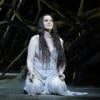
Beethoven’s Fidelio is not one thing. It is a “hybrid opera” of many components, a wonderful mix of Singspiel, rom-com, high drama, breathtaking tension, tearful lamentation, and in the finale, an overwhelming symphonic-choral celebration of life and liberty — Beethoven’s first “Ode to Joy.”
Balancing these disparate elements and presenting the work as a coherent musical experience is a daunting challenge, met superbly by SF Opera Music Director Eun Sun Kim at the premiere of a new production Thursday night.
How did that happen, what did some audience members and orchestra members pit see and hear? (If you question the validity of “ESK” as a nickname, try it on Google and find validation.)

The music, of course, comes from the singers and orchestra musicians. The conductor oversees their performance and shapes the sound of the music. That’s the understanding when writing about “Kim’s Fidelio.”
An observation from the orchestra: “She makes everyone sound good and remarkably, especially the chorus. [Chorus Master] Ian Robertson has them well prepared, but then she adds another layer of dynamics and sensitivity that is very special. Horn section was brilliant tonight; Kevin Rivard nailed two high E’s.”
From Los Angeles viewers of the livestream: “Impressed by the sense of calm assurance as she raised her baton ... of course that might have been from my knowing so few women who have preceded her on that podium. She appeared exuberant, and orchestra and singers fully responded to her lead.”
More from the orchestra (anonymously):
“[ESK makes] fabulous use of rehearsal time. it’s rare when we reach a dress rehearsal and are not fully prepared regarding character and musical/technical details.”
“I find that ESK has a phenomenal ear, very clear vision of what she wants, how the music tells the story ... and is one of the only conductors we have had who addresses intonation really well, calls it right.”
The pandemic might have slowed down or even paralyzed others but it just gave a brief respite for Kim after her dizzying schedule in recent years. According to her management’s website:
“Ms. Kim’s recent engagements have also included a new production of Die Fledermaus with English National Opera, Carmen at Opernhaus Zürich, Hänsel und Gretel, Carmen, and Die Fledermaus at Volksoper Wien, Il viaggio a Reims at Teatro Real Madrid, La traviata at Opéra de Marseille, and La bohème with Oper Graz.
“Concert performances comprise appearances with Orchestre de Paris, Beethoven Orchestra Bonn, and Stuttgart Philharmonic, as well as orchestras in Madrid, Marseille, Munich, Lille, Nancy, Palermo, Turin, Milwaukee, Calgary, and Santiago de Compostela.”
She also made an acclaimed appearance at the Cincinnati May Festival as that 148-year-old festival’s first woman conductor. (At the same time, another acclaimed young Korean conductor, Sung Shi-yeon, made news in that country by becoming Korea’s first woman chief conductor, leading the Gyeonggi Philharmonic.)

In San Francisco, where ESK was to make her debut as music director, opening the 2020 fall season with Fidelio, the pandemic-caused closure of the War Memorial delayed that debut by a whole year, until last month’s “Homecoming Concert,” and now, finally, Fidelio.
Was the Fidelio assignment announced before or after her appointment as music director? Word from SF Opera: “Casting and conducting assignments are planned several years in advance. This was the case with Eun Sun Kim, who was offered Fidelio before she made her debut conducting Rusalka.”

We all hear music with a unique pair of ears and the singular grey matter between them that are allotted to us. “ESK’s Fidelio” brought me back to a semilegal experience in a dark concert hall in Rome’s Foro Romano some decades ago. While on the way somewhere else, I heard music, opened a door, and found myself in the back of a hall without audience, but a stageful of singers and the RAI orchestra on the well-lit stage.
The only figure I recognized in the distance was Leonard Bernstein. I sat virtually invisible in the last row, hoping not to be removed by descendants of the Praetorian Guard. This was a rehearsal of Fidelio for the next day’s live RAI broadcast. Bit by bit, I recognized the cast, mostly by their voices from a year’s stay in Vienna: Birgit Nilsson, Helen Donath, Ludovic Spiess, Franz Crass. Spectacular as that lineup might have been, rather than individual performances, it was the robust, sweeping orchestral sound that created a game-changing impression, taking the music inside me. And that was also true in the War Memorial now.
For me, Fidelio and Missa Solemnis, were the only missing works from a Hungarian childhood dominated by the works of Beethoven, which were on blissful, seemingly eternal repetition in my world, including a two-month-long 24/7 broadcast of Symphony No. 9 as an engineering test for the country’s first FM station. (For Missa, the latent “discovery” came not all that long ago, with Kent Nagano and the Berkeley Symphony.)

On that day in Rome, in the dark auditorium, Bernstein’s driving, intense rhythms suddenly fully opened up the opera for me — and that never left me. I heard the same powerful, consistent drive from Eun Sun Kim’s orchestra this week, with a plus that I hope fellow Bernstein fans will not resent.
Unlike Bernstein’s occasionally overwhelming orchestral moments (which certainly didn’t bother Nilsson), ESK’s balances are especially notable for having the orchestra accompany the singers and never step on them. On opening night, a prima facie case occurred with the Act I quartet, always a problem of balancing four different voices across the footlights with the orchestra — and on Thursday night, all was exactly right.
Observed one orchestra member: “She very carefully follows the score, but sometimes because of balance asks us to play less. There are a lot of sFp [sforzando piano: in other words, she asks the orchestra to attack the note at Beethoven’s dynamic marking but pull back immediately] and the sFp is I think, more of a sudden accent ... but nothing unusual.”

A good, meaningful surprise at these performances — with Oct. 20, 22, 26, and 30 remaining — for those on the balcony of the War Memorial is the rebirth of the previously canceled OperaVision, thanks to a donation from Dianne and Tad Taube. Great as acoustics are up there, viewing the stage needs some help and OperaVision provides that. And how timely and important was saving the Taube Media Suite for all the recording and streaming during the pandemic and to this very day.





